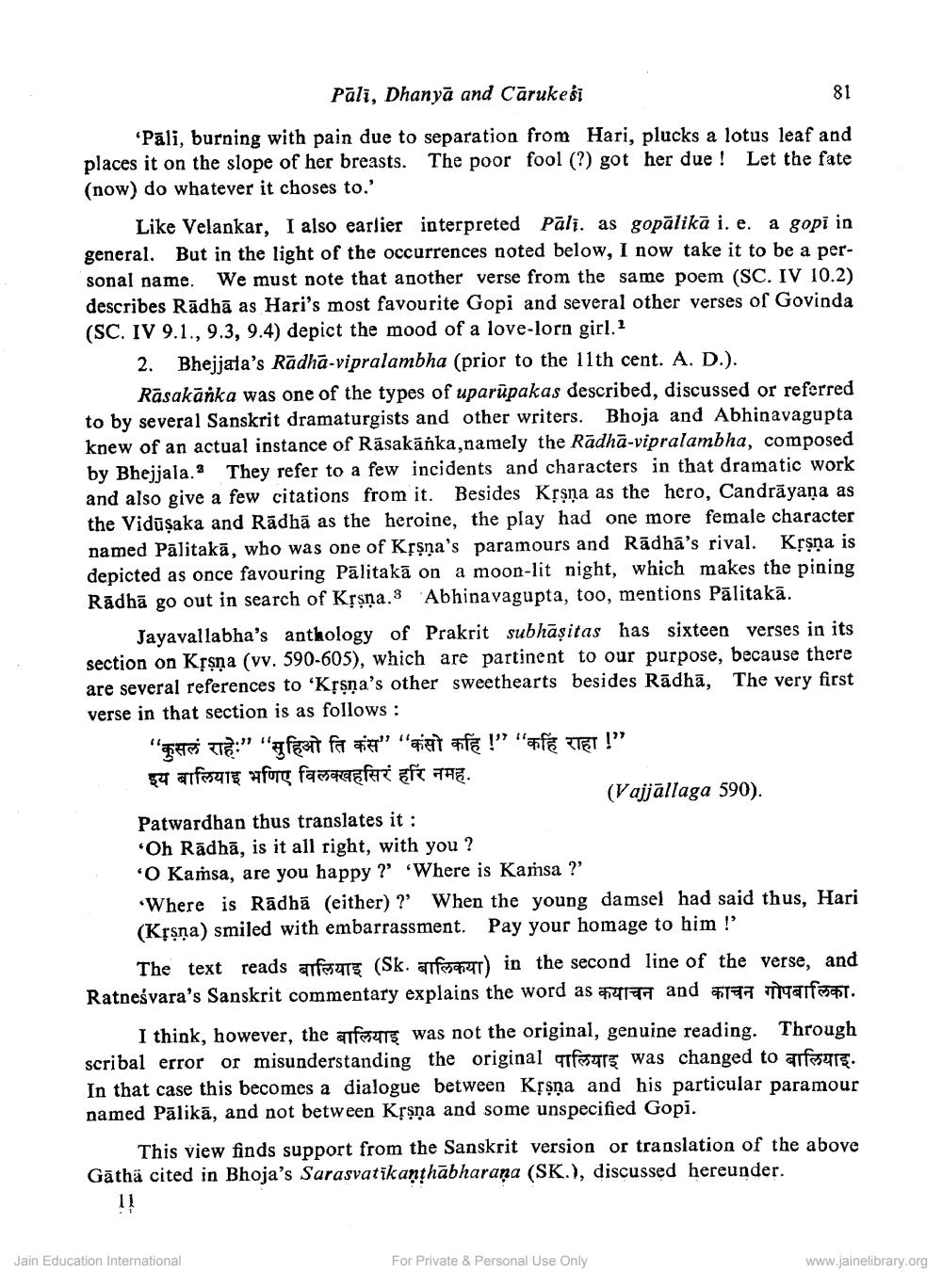Book Title: Pali Dhanya and Carukesi Author(s): H C Bhayani Publisher: Z_Aspect_of_Jainology_Part_2_Pundit_Bechardas_Doshi_012016.pdf View full book textPage 2
________________ Pāli, Dhanyā and Cāruke šī 81 Pāli, burning with pain due to separation from Hari, plucks a lotus leaf and places it on the slope of her breasts. The poor fool (?) got her due ! Let the fate (now) do whatever it choses to.' Like Velankar, I also earlier interpreted Pāli. as gopālikā i. e. a gopi in general. But in the light of the occurrences noted below, I now take it to be a personal name. We must note that another verse from the same poem (SC. IV 10.2) describes Rādhā as Hari's most favourite Gopi and several other verses of Govinda (SC. IV 9.1., 9.3, 9.4) depict the mood of a love-lorn girl.1 2. Bhejjala's Rādha-vipralambha (prior to the 11th cent. A. D.). Rāsakāńka was one of the types of uparūpakas described, discussed or referred to by several Sanskrit dramaturgists and other writers. Bhoja and Abhinavagupta knew of an actual instance of Rāsakāňka,namely the Rādhā-vipralambha, composed by Bhejjala. They refer to a few incidents and characters in that dramatic work and also give a few citations from it. Besides Krsna as the hero, Candrāyaṇa as the Vidūşaka and Rādhā as the heroine, the play had one more female character named Pālitakā, who was one of Kțşņa's paramours and Rādhā's rival. Kțşņa is depicted as once favouring Palitakā on a moon-lit night, which makes the pining Rādhā go out in search of Kșşņa.3 Abhinavagupta, too, mentions Pālitakā. Jayavallabha's anthology of Prakrit subhāşitas has sixteen verses in its section on Kșsņa (vv. 590-605), which are partinent to our purpose, because there are several references to 'Kșşņa's other sweethearts besides Rādhā, The very first verse in that section is as follows: "A TTE:" "Efent fa mp" "mat af !" "f TET!" इय बालियाइ भणिए विलक्खहसिरं हरि नमह. (Vajjallaga 590). Patwardhan thus translates it : "Oh Rādhā, is it all right, with you? 'O Kamsa, are you happy? Where is Kamsa ?' •Where is Rādhā (either) ? When the young damsel had said thus, Hari (Krsna) smiled with embarrassment. Pay your homage to him!' The text reads afate (Sk. allfil) in the second line of the verse, and Ratnesvara's Sanskrit commentary explains the word as कयाचन and काचन गोपबालिका. I think, however, the afoute was not the original, genuine reading. Through scribal error or misunderstanding the original पालियाइ was changed to बालियाइ. In that case this becomes a dialogue between Kșşņa and his particular paramour named Pālikā, and not between Kșşņa and some unspecified Gopi. This view finds support from the Sanskrit version or translation of the above Gāthä сited in Bhoja's Sarasvatikanthābharaṇa (SK.), discussed hereunder. 11 Jain Education International For Private & Personal Use Only www.jainelibrary.orgPage Navigation
1 2 3 4 5 6
